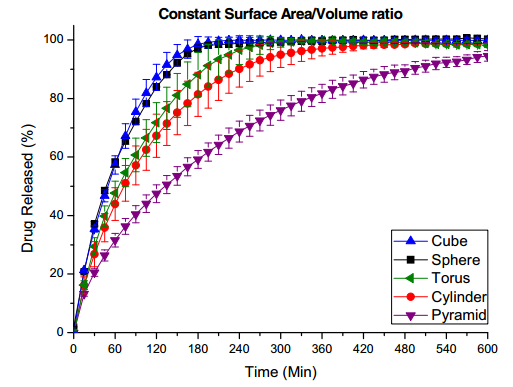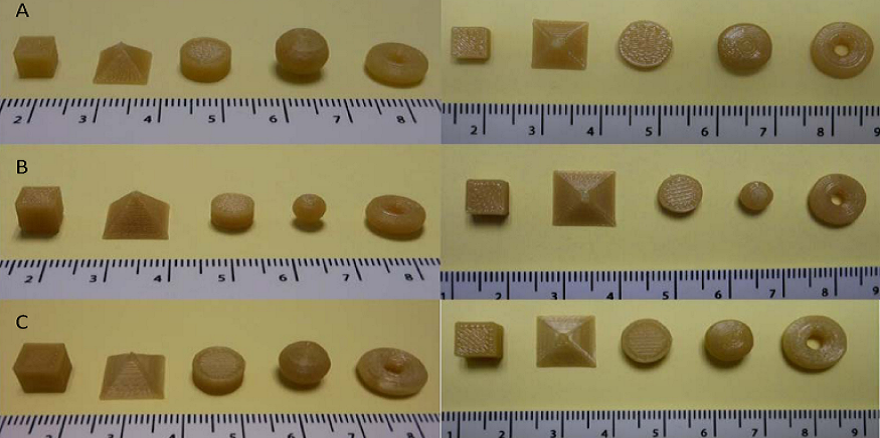
SEM images of the surface and cross-section of; (Top) PVA filament, (middle) PVA-paracetamol filament and (bottom) a section of a printed geometry (in this case from the torus)
Breakthrough technologies, particularly methods of 3D printing, are disrupting the healthcare industry in a countless number of ways. From medical implants and surgical models to prosthetic limbs, patients’ lives are being saved and made more fulfilling each and every day. One area which 3D printing promises to disrupt, although possibly overshadowed by some of the more feel-good stories that the media has been covering, is that of the pharmaceutical space.
The average American fills 12 drug prescriptions each year. Nearly 100% of these prescriptions are for mass produced drugs manufactured by pharmaceutical companies in only the doses which are most commonly prescribed. Additionally, although these pills come in a variety of colors, they are only produced in a handful of shapes.
While it may not be totally apparent at first, the shape and size of a pill can greatly change the ultimate effect it has on the human body. While the ‘one size and shape fits all’ approach has worked for decades, the future of medication focuses a bit more towards customization over mass production. In order to get to this point, we will need a way to customize medications both rapidly and in a precise manner. Researchers at the UCL School of Pharmacy, University College London, and FabRx Ltd., have recently published a paper called ‘Effect of Geometry on Drug Release From 3D Printed Tablets,’ detailing a method in which 3D printing and hot melt extrusion are used in the creation of otherwise difficult to produce, odd shaped medicinal tablets.
“The future of medicine design and manufacture is likely to move away from mass production of tablets/capsules of limited dose range towards extemporaneous fabrication of unit dosage forms of any dose, personalised to the patient,” wrote the researchers, which include Alvaro Goyanes, Pamela Robles Martinez, Asma Buanz, Abdul W. Basit and Simon Gaisford. “The factors driving this change include the development of low dose drugs with narrow therapeutic indices (for instance immunosuppressants and/or blood thinners), the increasing awareness and importance of pharmacogenomics (for instance in the drug sensitivity of cancer sufferers) and the need to formulate drug combinations. To face this challenge, the pharmaceutical industry needs to evaluate and embrace novel manufacturing technologies. One technology with such potential is 3D printing (3DP).”
While other bodies of research relied on passive diffusion from a solution as the means of loading the drugs, causing a very low total drug dosage, the researchers in this study opted to use a method of hot melt extrusion, a widely used technique within the pharmaceutical industry to evenly spread medication throughout a water soluble polymer (polyvinyl alcohol, PVA). This method is able to produce a drug infused filament. Their goal was to then 3D print various pill shapes which were impossible to manufacture via traditional powder compaction methods, and then ‘correlate geometric parameters with dissolution behaviour.’
To begin, the researchers first purchased water-soluble PVA filament from MakerBot, along with USP grade paracetamol (also known as acetaminophen, a generic form of Tylenol) and salts. They cut the filament into small pieces (approximately 2mm in length), basically turning the spool of filament into pellets. They then mixed in the paracetamol, and extruded the mixture from a Filabot filament extruder at 180 degrees C. They now had a drug infused 3D printer filament.
Now it was time to print the tablets. After designing them with AutoCAD 2014 and exporting the designs via an STL file, the researchers used the drug infused filament and a MakerBot Replicator 2X Desktop 3D printer to fabricate each uniquely shaped tablet.
“The sizes of the shapes were varied using the scale function of the software to fabricate tablets of constant surface area (275 mm2), surface area/volume ratio (1:1) or weight (500 mg),” explained the research paper. “In all cases, however, the ratio of the length, width and height of each shape was kept constant.”
Below you will find the statistics for each 3D printed tablet. They printed five different shapes; a cube, pyramid, cylinder, torus and sphere.
Once it was proven that these intricate pill shapes were able to be fabricated quite precisely via FDM 3D printing, it was now time for the researchers to investigate the quality of the tablets and how such shapes effect the dissolution of the medication. After conducting dissolution tests, researchers concluded that geometry does in fact play a major role in defining drug release profiles.  They found that when the surface area of the printed tablets were all kept constant, the drug release rates were the fastest in the pyramid shaped tablet, followed by the torus, cube, sphere, and finally the cylinder. This order is directly correlated with the tablets’ surface area/volume ratio, with the pyramid tablet having the highest value and the cylinder the lowest. This led the researchers to conclude the following:
They found that when the surface area of the printed tablets were all kept constant, the drug release rates were the fastest in the pyramid shaped tablet, followed by the torus, cube, sphere, and finally the cylinder. This order is directly correlated with the tablets’ surface area/volume ratio, with the pyramid tablet having the highest value and the cylinder the lowest. This led the researchers to conclude the following:
“Drug release kinetics from tablets showed no dependence on the surface area but rather on surface are to volume ratio, indicating the influence that geometrical shape has on drug release profile. Tablets of similar mass showed little difference in dissolution profiles that could be explained by the erosion-mediated process that drives the drug dissolution.”
Thus, the research has indicated that the ability of 3D printers to fabricate pills in various shapes and sizes could play a significant role in the future customization of medication. For instance, Patient A may require a rapid release of medication within their bloodstream for whatever ailment they are suffering, while Patient B may require a slower, more steady release of the same drug. Patient A could be provided the drug in a pyramid shape, or better yet provided the drug infused filament so that they themselves may print it at home, while Patient B could be provided with a cylindrical shaped pill.
There’s no doubt that such methods outlined in this paper could have a significant impact on the future of medication. Let’s hear your thoughts on all of this in the 3D printed medication forum thread on 3DPB.com.
Subscribe to Our Email Newsletter
Stay up-to-date on all the latest news from the 3D printing industry and receive information and offers from third party vendors.
You May Also Like
Gorilla Sports GE’s First 3D Printed Titanium Cast
How do you help a gorilla with a broken arm? Sounds like the start of a bad joke a zookeeper might tell, but it’s an actual dilemma recently faced by...
Nylon 3D Printed Parts Made More Functional with Coatings & Colors
Parts 3D printed from polyamide (PA, Nylon) 12 using powder bed fusion (PBF) are a mainstay in the additive manufacturing (AM) industry. While post-finishing processes have improved the porosity of...
$25M to Back Sintavia’s Largest Expansion of Metal 3D Printing Capacity Since 2019
Sintavia, the digital manufacturing company specializing in mission-critical parts for strategic sectors, announced a $25 million investment to increase its production capacity, the largest expansion to its operations since 2019....
Velo3D Initiates Public Offering in a Bid to Strengthen Financial Foundations and Drive Future Growth
Velo3D (NYSE: VLD) has been among a number of publicly traded 3D printing firms that have attempted to weather the current macroeconomic climate. After posting a challenging financial report for 2023,...


































